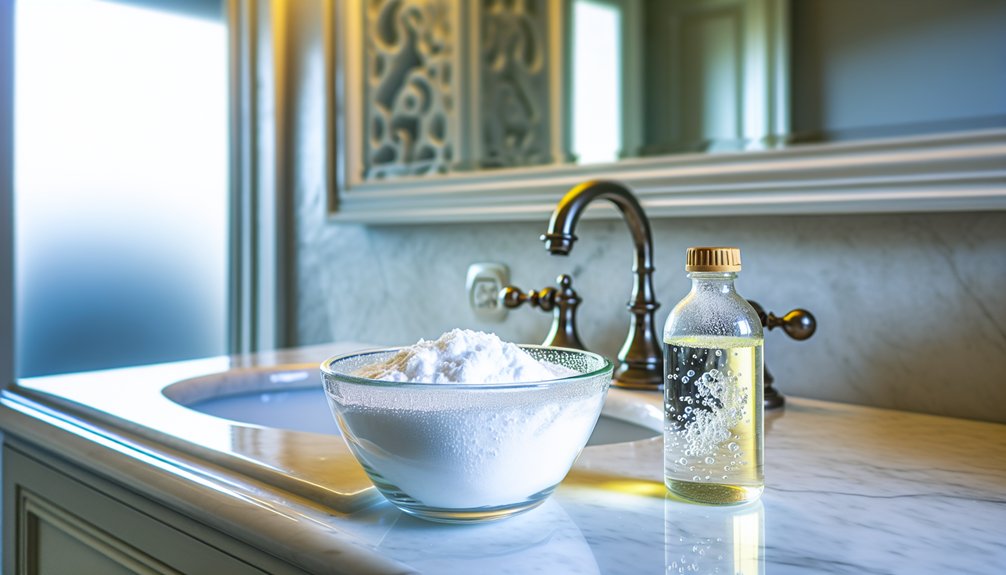DIY remedies for bathroom drain clogs include several eco-friendly techniques. The baking soda and vinegar method uses a fizzing reaction to clear debris. Boiling water is effective against soap scum buildup. A plunger can tackle stubborn blockages, especially when combined with warm water. Regular maintenance, such as monitoring drain performance and avoiding grease, can prevent future clogs. For more detailed methods and safety precautions, additional insights await to enhance your drain maintenance efforts.
Baking Soda and Vinegar Method

Although clogged drains can be a frustrating household issue, the Baking Soda and Vinegar method offers a simple and effective solution. This eco-friendly remedy involves pouring ½ cup of baking soda followed by ½ cup of vinegar down the drain, creating a powerful fizzing reaction. This reaction generates carbon dioxide and water, which helps to loosen debris and grime lodged within the pipes.
For best results, it is advisable to plug the drain after adding the mixture and let it sit for about an hour. Following this, flushing with hot water guarantees a thorough cleaning. Regularly employing this method not only helps maintain clear drains but also prevents future clogs, making it a cost-effective choice. For added potency, users can use ⅓ cup of each ingredient, making sure the mixture is promptly poured to maximize effectiveness. Consequently, the Baking Soda and Vinegar method stands as a liberating alternative for maintaining clean drains.
Boiling Water Technique
The Boiling Water Technique serves as a straightforward yet effective method for tackling bathroom drain clogs, particularly those resulting from soap scum buildup. This approach utilizes the heat of boiling water to dissolve and remove obstructions in the drain. To implement this method, one should boil approximately two liters of water and pour it down the clogged bathroom sink in stages, allowing time for the water to clear the blockage.
The Boiling Water Technique effectively clears bathroom drain clogs caused by soap scum buildup.
- Maintain minimal standing water in the sink for peak results.
- Repeat the process multiple times for stubborn clogs.
- Exercise caution with PVC or plastic pipes to prevent damage.
Using a Plunger

Using a plunger can effectively clear stubborn bathroom drain clogs, making it an essential tool for homeowners. To maximize its potential, one should opt for a wider-mouthed plunger designed for sinks. Begin by filling the sink halfway with warm tap water to create a seal and enhance suction. Position the plunger over the drain and plunge vigorously in an up-and-down motion for several seconds to dislodge the clog, which may consist of hair or soap scum.
| Step | Action | Result |
|---|---|---|
| 1. Fill Sink | Use warm tap water | Create a better seal |
| 2. Position Plunger | Center over the drain | Enhance suction |
| 3. Plunge | Vigorously for several seconds | Dislodge the clog |
| 4. Clean Up | Address any water backup | Maintain a clean environment |
This versatile method is invaluable for effective drain maintenance.
Frequently Asked Questions
How Do You Unclog a Bathroom Drain Naturally?
To unclog a bathroom drain naturally, one can utilize eco-friendly cleaners and effective plumbing tips. Regular cleaning with hot water helps dissolve soap buildup, while a mix of baking soda, vinegar, and essential oils can provide powerful natural solutions. Additionally, hair removal is vital in preventing clogs. Implementing preventive measures, such as flushing drains with boiling water, guarantees peak drain maintenance and promotes a more liberated, hassle-free bathroom experience.
How to Clean Drain Blockage With Home Remedies?
In the quest for clarity, one may find liberation through homemade solutions for drain blockages. A salt mixture, combined with boiling water, creates a powerful cleansing force. Adding dish soap can ease stubborn residues, while essential oils refresh the space. Employing the plunger technique or a drain snake can dislodge hair removal issues. Enzyme cleaners offer a gentle touch, and preventive measures guarantee future tranquility in the plumbing domain. Each method reveals a path to harmony.
Why Should You Never Use Baking Soda and Vinegar to Unclog a Drain?
The use of baking soda and vinegar for unclogging drains poses several risks. Baking soda dangers arise from potential sediment buildup, while vinegar reactions can damage sensitive plumbing systems. These chemical reactions often lack drain effectiveness against tough clogs, leading to further clogging issues. Additionally, long-term effects may include worsening plumbing risks and environmental impact. Alternative solutions, such as professional services or stronger cleaners, are recommended for safety and effective results.
What Is the Best Thing to Put Down a Clogged Drain?
When considering the best solution for a clogged drain, individuals often explore a variety of options. Eco-friendly choices like homemade solutions using natural ingredients, such as baking soda and vinegar, can be effective. For tougher clogs, liquid drain cleaners may be useful. Implementing drain maintenance tips and clog prevention strategies enhances plumbing safety. Additionally, utilizing plumbing tools, such as a wet/dry vacuum, offers practical avenues for ensuring long-term drain health without harsh chemicals.



